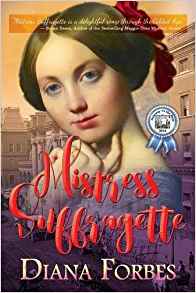Mistress Suffragette
Rhode Island debutante Penelope Stanton has lost her chance to make an advantageous marriage due to her father’s failed business during the Panic of 1893. Her fiancé has abruptly broken off their engagement. Her parents want her to move to New York and become a schoolteacher so she can send some of her wages home to help out the family. But New York is the home of Edgar Daggers, a married man who won’t stop pursuing Penelope. To avoid him, she goes to Boston and becomes a reluctant but successful speaker for the women’s suffrage movement.
Oddly, the first section of the novel gives no hint of Penelope’s later feminist concerns, seeming instead like a bizarre sexual nightmare in which Penelope is assaulted by apparently respectable people (both men and women). While the author may have been attempting to show the need for feminism, Penelope’s reactions are inconsistent and her motivations unclear.
The novel improves in the middle section, and I became more invested in the story and enjoyed some of the new characters introduced in Boston. The narrative voice has a certain charm and humour: “He had about him the air of a Russian intellectual, although I was certain I had never met a Russian in my life or, for that matter, an intellectual.”
Unfortunately, the last section of the novel resembles the first part, veering wildly between serious, moving scenes (Penelope showing sensitivity towards a black elevator operator) and ridiculous, sordid ones bordering on slapstick (a female companion helps Penelope steal a pie by putting it between her legs under her skirt).
If you’re looking for a light read and don’t mind some anachronisms, you may be entertained by Penelope’s adventures.










